DOI:10.32604/csse.2023.027987

| Computer Systems Science & Engineering DOI:10.32604/csse.2023.027987 |  |
| Article |
Deep Learning Enabled Social Media Recommendation Based on User Comments
1Department of Computer Science and Engineering, Government College of Engineering, Salem, 636011, India
2Department of Information Technology, Sona College of Technology, Salem, 636005, India
*Corresponding Author: K. Saraswathi. Email: ksaras2k15@gmail.com
Received: 30 January 2022; Accepted: 02 March 2022
Abstract: Nowadays, review systems have been developed with social media Recommendation systems (RS). Although research on RS social media is increasing year by year, the comprehensive literature review and classification of this RS research is limited and needs to be improved. The previous method did not find any user reviews within a time, so it gets poor accuracy and doesn’t filter the irrelevant comments efficiently. The Recursive Neural Network-based Trust Recommender System (RNN-TRS) is proposed to overcome this method’s problem. So it is efficient to analyse the trust comment and remove the irrelevant sentence appropriately. The first step is to collect the data based on the transactional reviews of social media. The second step is pre-processing using Imbalanced Collaborative Filtering (ICF) to remove the null values from the dataset. Extract the features from the pre-processing step using the Maximum Support Grade Scale (MSGS) to extract the maximum number of scaling features in the dataset and grade the weights (length, count, etc.). In the Extracting features for Training and testing method before that in the feature weights evaluating the softmax activation function for calculating the average weights of the features. Finally, In the classification method, the Recursive Neural Network-based Trust Recommender System (RNN-TRS) for User reviews based on the Positive and negative scores is analysed by the system. The simulation results improve the predicting accuracy and reduce time complexity better than previous methods.
Keywords: Recommendation systems (RS); social media; recursive neural network-based trust recommender system (RNN-TRS); user reviews
With the development of the World Wide Web, information is growing faster than ever, and the problem of information overload that online users face is becoming more and more acute. Consumers are increasingly relying on online product reviews to make purchasing decisions. It can get reviews directly from the site where you bought the reviews, but customers can also use various sources such as Google and Amazon to get high-quality reviews. When people post their latest purchases on social media, social media can be a great resource for searching for product reviews. However, commenting from social media is difficult to provide and integrate. It is difficult to find reviews for in-store products because there are no reviews for the products in the store. Consumers need to stand in front of the product, visit multiple websites, get reviews, and integrate all the information to make a decision.
Social media (SM) is the most popular and fast data creation application on the Internet, and research on this data is increasing. However, it isn’t easy to process such large amounts of data effectively, so a system like machine learning that can learn from this data is needed. Machine learning techniques allow the computer to learn on its own. Over the past few decades, many papers on SM have been published using machine learning techniques. Several recommendation algorithms have emerged, of which joint filtration and content-based semantic models are the most common algorithms in the early development of referral systems, which have grown significantly over the past decade. Challenged with significant achievements of in-depth learning technology in many artificial intelligence applications, deep learning-based recommendation models have gradually become the focus of researchers.
Recommendation systems recommend products to users by evaluating the user’s rating for the item (book, movie, vacation, etc.). Scores can be assessed using heuristics and machine learning techniques. There are three basic approaches to making recommendations in the literature: content-based, collective filtering, and hybridisation. Uses item similarity to provide content-based recommendations, and collective filtering uses user similarity. Trust-based recommendations work better than user-based methods.
Social media referral systems are very popular. However, the RS system requires a lot of user and product information, so companies that do not have enough data cannot use referral systems. Recommendation systems can be divided into three types. The most widely used technique is co-filtration. The previous approach had some limitations: data capacity scaling problems. Recently, a new approach, the Recursive Neural Network Trust Recommendation System (RNN-TRS), has played a key role in addressing these issue analyses and has made significant contributions to improving and resolving issues.
The social networking map and user-item team improve the predictive accuracy of traditional referral systems. Integrate the optimal trust path selection algorithm, identify multiple recommended trust paths, and determine the integration path between users. The assignment process uses the friendship between users and tags with user tags for suggestions. User item labels can be considered as a two-dimensional matrix. Gather identical users and calculate the similarity between users and the relationship between users and items. The purpose of clustering is to identify best friends for a realistic referral mission. Designed the rules of social normalisation using different aspects of social networking information. Different friends may have different hobbies or vice versa. Even if friends in the same group follow the same plan, they may like it differently. The RNN-DRS algorithm identifies aggregation paths. Evaluate the effectiveness of this proposal for the predictive accuracy of the actual data set. Tests have shown significant improvements over traditional recommendation systems.
Social Media Personal suggestions are important to help users find the right information. On social media to read users ‘preferences in-depth, on large amounts of user data, especially users’ online activities (tags/ratings/check-ins, etc.) to read users’ preferences in depth [1] However, exposing such user activity data often makes users vulnerable to guessing attacks, as personal data can often be inferred from users’ activity data [2]. With the growing popularity of Multimedia Social Networks (MSNs), it is important for referral systems to cultivate user interest in different environments on such networks [3]. However, it isn’t easy to mine the user’s current settings based on the MSN session. New recommendation algorithm for session-based recommendations based on social context analysis and collective filtering [4]. In particular, the algorithm predicts the target user’s rating based on the target user’s close neighbours and past behaviour. Today, social websites are on the rise. Information obtained from social media users has led to several referral systems exploring user preferences and finding the best products to recommend to users [5]. Many have developed referral systems using social media sites such as Twitter.
A wealth of friendships between users will support such applications. For example, it helps provide cognitive tasks in the sense of the mobile crowd [6]. Therefore, the Mobile Social Network (MSN) should provide users with suggestions on where to connect and explore friend suggestions to enhance their friendship. Most existing strategies use user relationships or similarities for recommendations [7]. It ignores the many types of links between users, such as links between authors of a general article or an educational network based on a common topic. Social media Weibo is widely used to get information like news [8]. Distinguishing which specific information is reliable is a real challenge. The anonymity of Weibo, in particular, will obscure the user’s credibility. Incredible content disturbs the balance of society [9]. Accordingly, a great deal of exploration has been done on the unwavering quality of mechanised microblogging; however, the greater part of them offer various ideas of dependability [10]. It appears to be that the issue isn’t tackled. Via web-based media, client evaluations and remarks are perceptible by all clients and verifiably affect future appraisals [11]. Assuming these clients settle on resulting choices about a thing, they might be impacted by the current rating. Web-based media locales permit clients to impart and share their thoughts and data on the web [12]. The utilisation of online media destinations like Instagram has spread to practically all style marks and is viewed as a vehicle to begin organisations [13]. With the utilisation of web-based media for showcasing correspondence for design brands, there is a requirement for experimental examination and extraction of style information. The traditional approach requires adequate historical data or constant monitoring of patients’ activities to identify patients with psychiatric disorders [14]. The amount of data makes it difficult for users to access priority events based on features stored on their social networking profiles. To overcome this limit, various event recommendation systems have been developed [15]. However, these systems use a limited number of event dimensions and user capabilities.
Use machine learning and Data Envelopment Analysis (DEA) systematically to analyse enterprise financial metrics to gain insight into the types of influential news in Twitter news, Twitter metrics and social media networks [16]. It used automated machine learning to categorise tweets from selected furniture retailers in the United States. At the same time, multiple-input measurements are analysed using different DEA models to obtain performance rankings for the selected brand. Recently, referral systems have become widespread and used in almost all fields [17]. From knowing which videos you can recommend to users of streaming sites to products sold on e-commerce sites? These systems are driven by the vast amount of data collected and collected from review sites and social media sites.
Customised style proposal issue via online media information. To put it plainly, prescribe new garments to your web-based media clients as per your design taste [18]. For this reason, a thing to-bundle metric learning system for working out the comparability between a client’s recorded design things and new style things. Extricate highlights from multimodal road view style things. Regular client collaboration with printed content, such as remarks, evaluations, labels, web journals, and tributes, changes web-based media locales into customised information bases that focus on clients’ different preferences. Because social media content is so large, it is difficult for end-users to access relevant information. The need for tools to deal with this environment led to referral systems. Referral systems are emerging as an integral part of all industries except travel and tourism. Given the rapid development of social media usage and the large amount of data generated by this channel, it is considered the main input data source for modern referral systems. In addition to historical data, social media data is also an important input source for data analysis. The main challenge to be observed with social media data is the enormous, high dimension. Clustering is a proven technique in data analysis that isolates relevant data for processing and minimises large amounts of data. Use Twitter data to personalise your travel recommendations. Use the machine learning classification model to find travel-related tweets. Travel tweets are used to customise suggestions for users’ preferred destinations [19]. Interesting places are divided into historic buildings, museums, parks and restaurants. It also mines travel tweets from users’ friends and followers to make the model more personal.
In this situation, the issue of casting a ballot assignment is comparable to joining a complex vector with a bunch of vectors (profile of electors who support a specific ideological group). Beforehand, this component was given. Make a model addressing each party’s “normal” citizen and compute the distance between the dynamic client and each party’s “normal” elector. The lines between internet business and informal communication are turning out to be progressively obscured. Numerous web-based business destinations support the social login system, which permits clients to sign in to the webpage utilising an informal community ID, for example, a Facebook or Twitter account. Clients can post their recently bought items on Weibo with a connection to the online business item page [20]. The web-based media work-based travel reference framework gives tweaked spots of interest custom fitted to the client’s particular requirements and inclinations. By and large, client inclinations for objections change over a long time.
The Recurrent Neural Network (RNN) model can consider the sequence and time interval of the user’s item usage history. The recurrent neural network model predicts the probability that a user will access an item given this non-uniform feedback of the user’s time. As far as I know, the deep neural network model is the first to solve the time non-uniform feedback recommendation problem. Comparison results show that the proposed method is superior to the state-of-the-art approach. This shows that newer models perform better than previously widely used recommendations, such as long-term RNN-TRS-based models in the database.
Fig. 1 shows the data collection reads both the conditional informational index and interpersonal organization informational collection. The strategy distinguishes the rundown of clients and recognizes their logs from the two of them. The technique recognizes a rundown of talks and exchanges from the semantic informational index. The softmax activation function analyses the feature weights, and the input data set has been initialized with the Recursive Neural Network-Trust Recommender System (RNN-TRS) using classifications. The number of layers is initialized with the number of interests identified at the classification stage and improving accuracy.
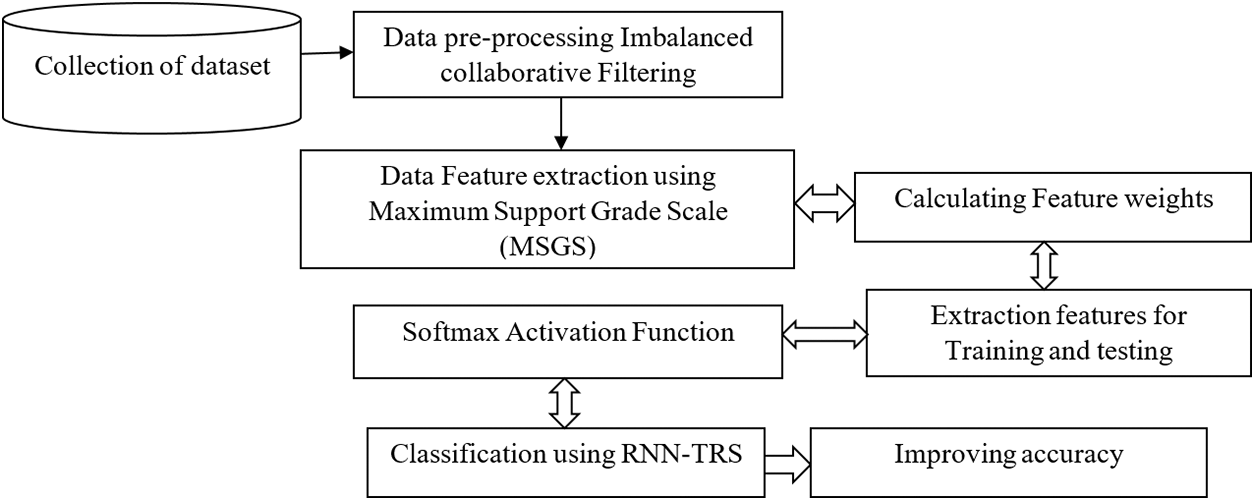
Figure 1: The proposed block diagram
Data is an important part of the investigation that needs to be collected, analyzed, and validated with the expected results from the relevant sources. Data can be collected through interviews, observations, experiments, surveys, simulations and more. The proposed work is a user of social networks, so the data is collected through an observation process. Because this work aims to study user behavior on social networks, customized web crawlers are designed to capture your timeline and friend activity information. Collect a list of a user’s friends, timeline, activity feeds, and chat details from the user’s Facebook information available on the server. Independent features collected from this data are posts posted by the user regarding the user’s type, posting time, poster, CD, poster name, and associated response. Reply content includes content time, ID, likes or comments, post likes, and content shared by friends in the community. It also includes chat history with users’ friends, such as chat date and time, messenger ID, messenger name, thread ID, message content, and interests specified in the user’s profile. Depending on these features, user posts by date and the corresponding number of responses by ego users regarding likes, comments, and chats are recorded separately.
3.2 Data Pre-Processing Using Imbalanced Collaborative Filtering (ICF)
Data pre-processing is one of the most important processes in social media data, the first step in the data mining process. Pre-processing can prepare the original educational data to solve and adequately provide specific educational challenges through data mining algorithms. Pre-processing techniques are used before deep learning algorithms. Standardization is related to a concrete representation of the original functionality. The Imbalanced Collaborative Filtering (ICF) used for removing the irrelevant contents are filleting. The impact on the normalization of classification results is standardized by the technology used and is affected by high classification accuracy.
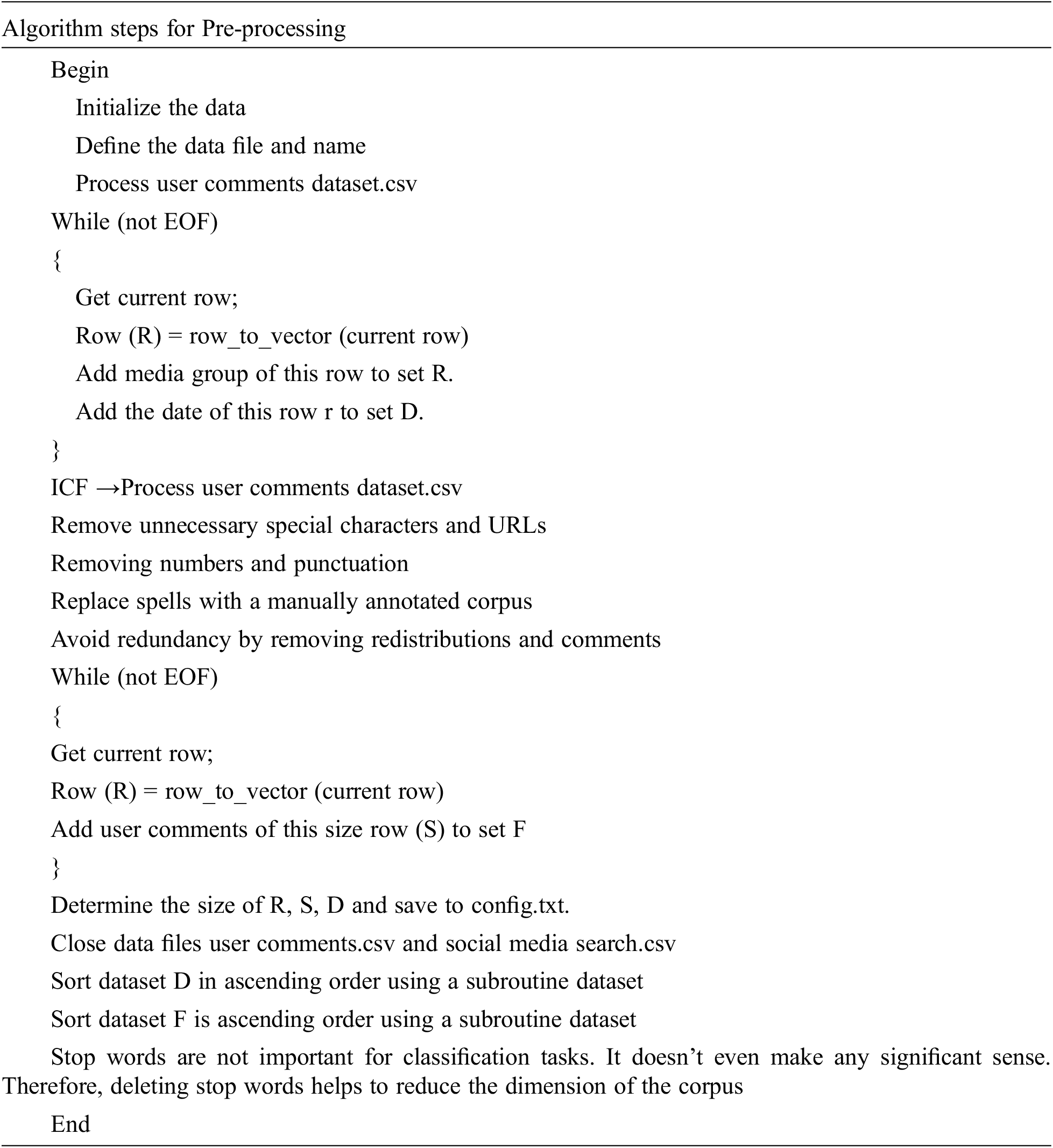
EOF-End of the file, Pre-process the database separately for reviews of user words, emotion words, and negative words. The system uses title sampling algorithms to extract the product feature with the clean input text. Its work uses a title prototype, thus creating words. User perception similarity is calculated using scores for items and perception dictionaries.
3.3 Extracting Features from the Data
When using feature extraction techniques, when reviews are categorised into different categories, the features of the corresponding product are retrieved. Feature extraction is performed by filtering the collected reviews individually. The process starts by collecting textual comment data, a regular text separator. After initial pre-processing, review data is filtered and screened. The filtered and sifted review data is then examined to compute word score metrics. All the relevant and necessary information from the collected dataset are parsed and retrieved. Maximum Support Grade Scale (MSGS) using a Maximum number of retrieved data, relevant features count, mentions count, Remarks supporter to followed proportion, normal retweet count, adherents count, normal retweet recurrence, account age is determined. The record of the client is determined utilising the chosen data, in particular the time at which the remarks is made and the time at which the record of the client is made. The normal retweet count is determined by questioning the data set to choose a specific client’s absolute amount of audits.
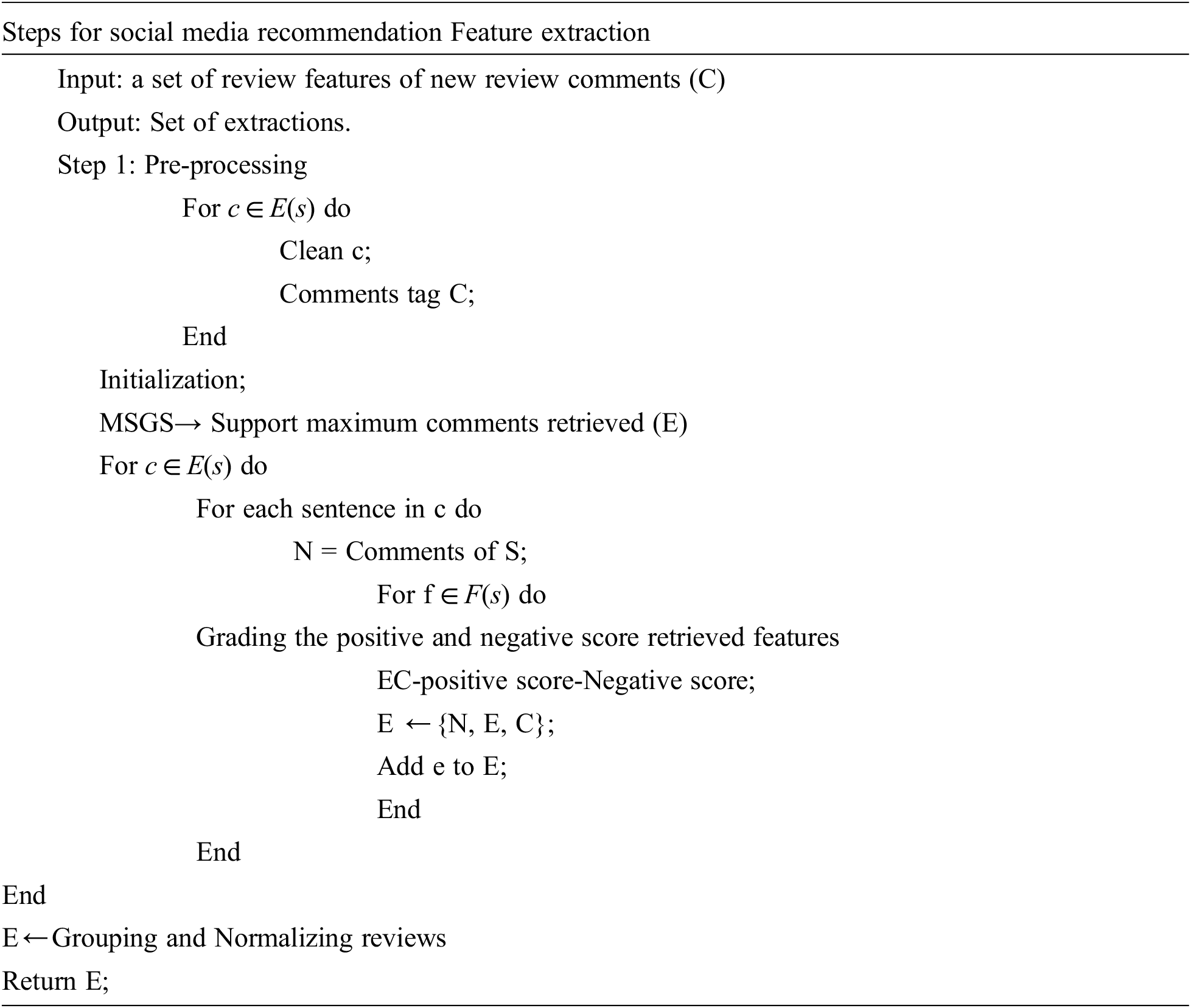
Where N-Characteristics of user comments, S-length, E-Positive score, C-Negative Score, Connections between clients give the best proof to decide client impact, connection highlights, for example, retweet count, refers to count, Comments devotee to followed proportion, normal retweet count, adherents count, normal retweet recurrence, account age are chosen for investigation. Normal retweet recurrence is determined using the client’s normal retweet count and the normal. Believers consider it is additionally chosen a component in the pre-handling step.
3.4 Softmax Activation Function
The Softmax activation function is used between the fully-integrated intermediate learning process and output layers. The activation function converts the values obtained from fully connected layers into probability values at intervals of [0, 1], and the sum of these probability values is equal to 1. Applied the Softmax function to the vector of real values obtained by the last hidden layer of RNN-TRS and calculated two values: positive reviews and negative review marks.
where, f-softmax activation method, s-input values,
3.5 Classification Using Recursive Neural Network-Trust Recommender System (RNN-TRS)
The Recursive Neural Network-Trust Recommender System (RNN-TRS) reduces the error rate and predicts and recommends real users. RNN-TRS is designed by extracting user data, quantifying user confidence scores, classifying trusted users, and predicting and recommending top trusted users. User data is collected from social network users based on pre-processed user comments to obtain clean data. Semantic Web trust comes from attribution and identifies trusted reviews for users. Reliable software referral systems adopt the concept of social networking services and use social contact information. Trusted feedback improves referral settings from the spam issue and accurately predicts user preferences. If indirect trust satisfies the trust characteristics of social contexts, it will ensure that referral systems work better. Because the structure and quantity of social link information are contextual, using the concept of trust in the social environment requires an approach that enhances implicit and explicit trust with minimal social link information. The proposed RNN-TRS system uses a user-item rating matrix to construct an asymmetric indirect trust network and convert trust spread measurements into directed and weighted trust networks.
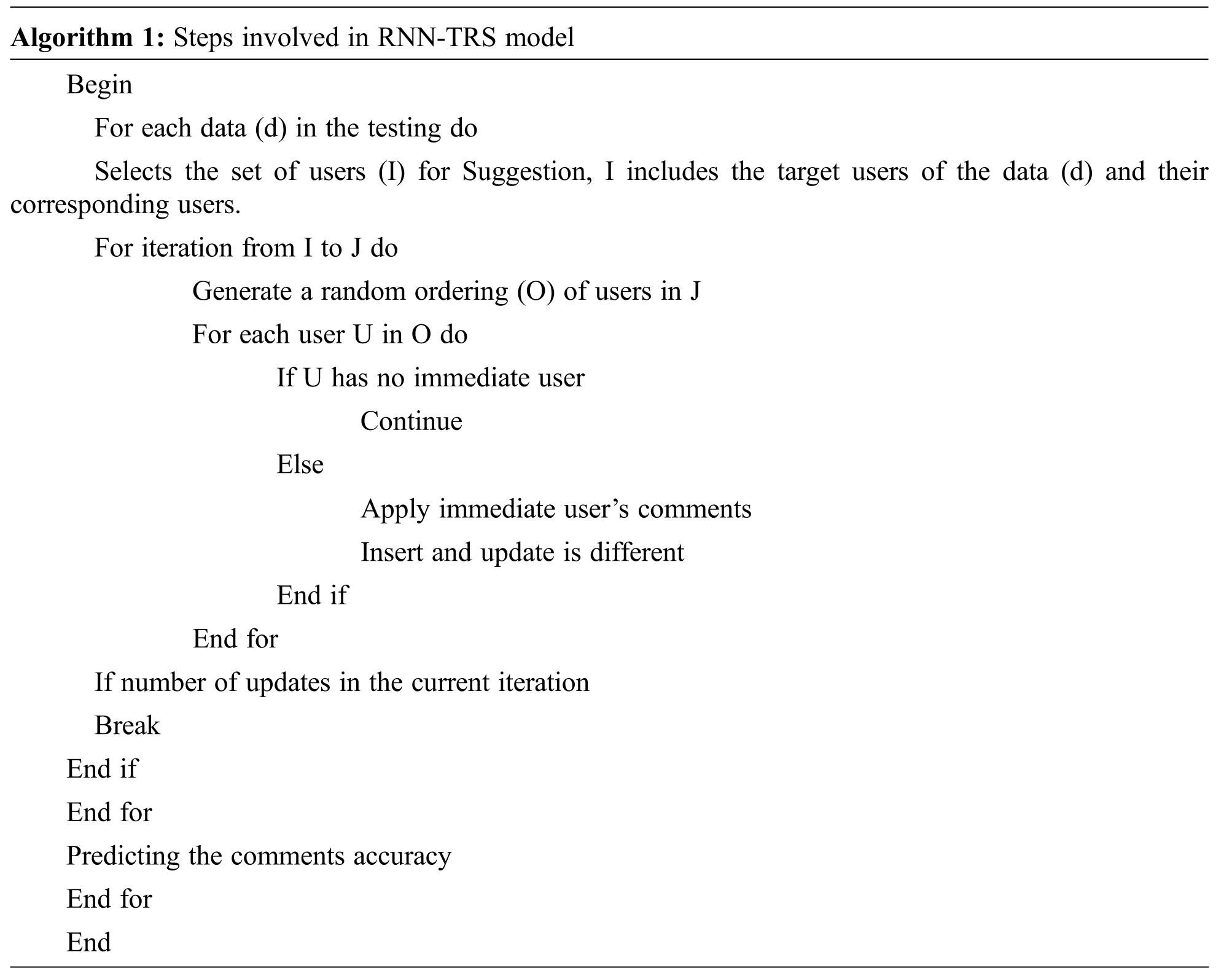
Extract information from a genuinely online interpersonal organisation and our examination of this enormous informational collection uncovers that companions tend to choose similar things and give comparable appraisals. Trial results on this informational index show that our proposed framework not just further develops the forecast precision of recommender frameworks.
The recommended generation algorithm is implemented based on the proposed multifunctional semantic similarity, and its performance is evaluated under different parameters. The proposed method is implemented using high-level Python, and the results obtained are compared with other methods. The classification accuracy of the proposed method, the accuracy of interest estimates, the false-positive ratio, the time complexity and the recommended accuracy are analyzed using traditional and Facebook databases. Simulation results include better results than existing settings.
Tab. 1 shows the details of the estimates used to measure the effectiveness of the proposed method. The transaction used a transaction database managed by a local mall and a Facebook database provided by the UCI repository. There are 19 attributes and 500 rows in the Facebook database. The database is linked to the transaction database for evaluation. Evaluate by changing the number of users. Make estimates of 10,000 users, 30,000 users and 50,000 users. Performance is measured by various parameters for each rated level and is presented in this section. Effectiveness of recommended methods compared to sophisticated results.

Fig. 2 shows Classification accuracy performance is evaluated for different numbers of clients, and the results of different strategies are compared. The accuracy of grouping is better than the various techniques. The evaluation results for each test case show that the proposed RNN-TRS is 97% classification improves performance.
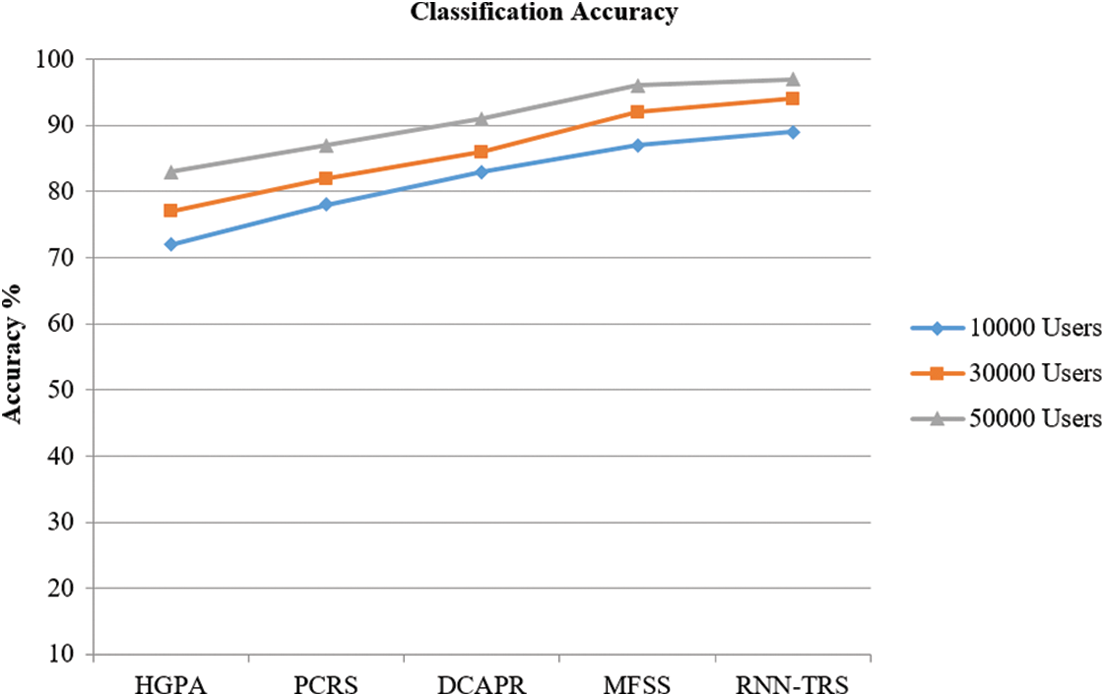
Figure 2: Analysis of the classification accuracy
Fig. 3 Performance of The method results is shown in the interest calculation with a different number of users than other methods. The proposed algorithm RNN-TRS provides a higher rate prediction 97.2% accuracy compared to other methods. Estimates are made for different numbers of users on the system. The proposed scheme provides higher predictive accuracy than the other methods considered in each case. Adding the proposed quantity can improve the accuracy of the interest calculation more than other methods.
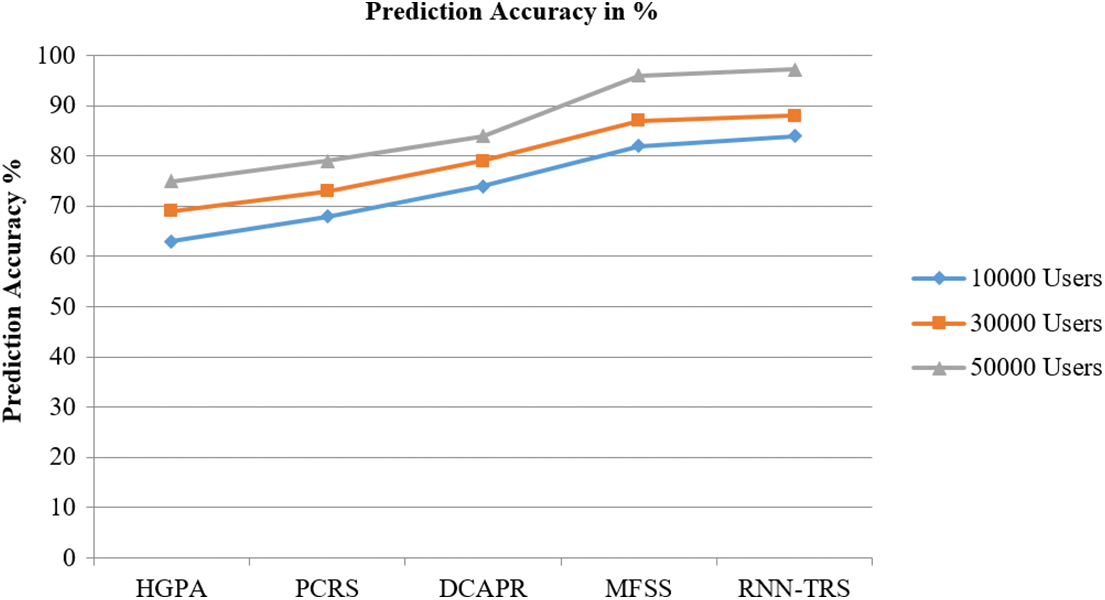
Figure 3: Analysis of the prediction accuracy
Incorrect classification rate performance is measured by the number of different users and compared with the results of other methods. The proposed algorithm generates a lower error rate than other methods. Fig. 4 shows the loss function or misclassification rate based on traditional and Facebook databases. The proposed method reduces the error rate than the existing method. Incorrect classification rate is estimated by changing the number of users. The proposed scheme had a lower misclassification rate than the other methods in each trial case considered. Adding the proposed RNN-TRS is a 3% metric to the interest calculation reduces the error rate.

Figure 4: Analysis of the false ratio
Fig. 5 shows the effectiveness of these methods in referral generation is measured by a different number of users and compared with the results of other methods. The proposed RNN-TRS algorithm provides higher recommended 97% generation accuracy than other methods. Evaluate by varying the number of users on the system. The proposed method provides higher recommended generation accuracy than the other methods in both cases. Adding this measurement can improve the accuracy of the recommended generation compared to other techniques.
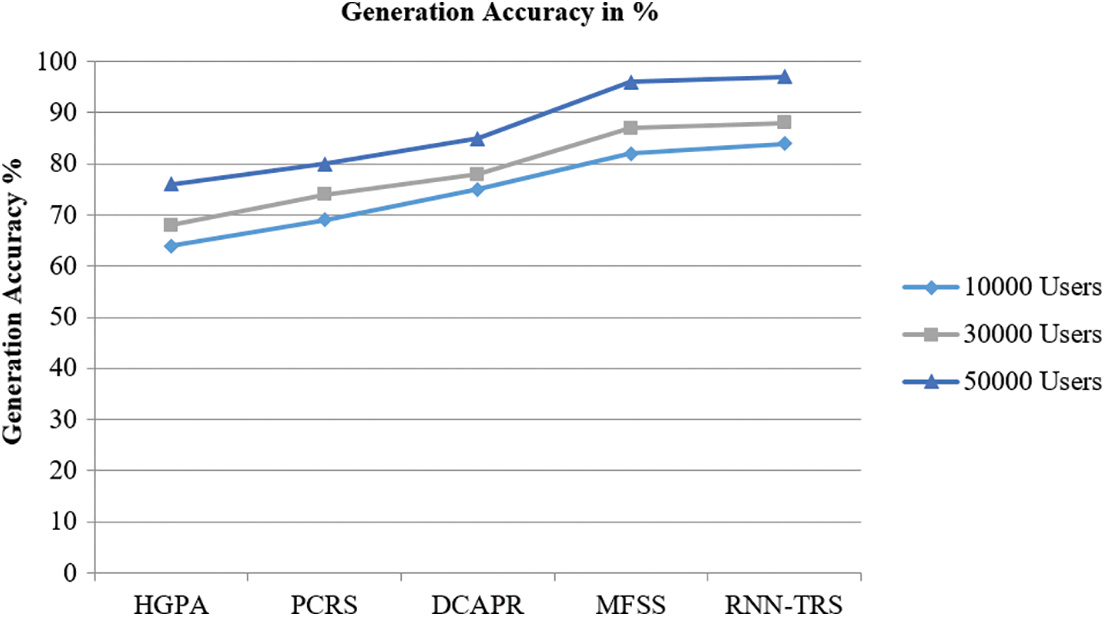
Figure 5: Analysis recommendation generation accuracy
Recommend social media products based on partners and related reviews. Extensive tests are conducted to compare review-based nominees and their hybrids. Show that a combination of tags used directly and tags used by others effectively represents topics of interest to users. This review-based and profile-based referrer produces more interesting items for users than the most effective referral proven in previous works. The proposed method, Recursive Neural Network-Trust Recommender System (RNN-TRS) analysis to improve accuracy is 97%, prediction accuracy is 97.2%, the false ratio is 3%, and generation accuracy is 97%. The user receives a request from another similarly trusted user to recommend the same trusted user. Fundamentals of Deep Learning Recommender System (RS) includes samples, datasets and evaluations. At the same time, it provides some possible research directions for related fields. The emergence of deep learning has brought many innovations in advanced RS, which can provide efficiency for comments prediction with a basic understanding of deep learning-based RS. In future, hyperparameter optimization process can be presented to improve the overall performance.
Funding Statement: The authors received no specific funding for this study.
Conflicts of Interest: The authors declare that they have no conflicts of interest to report regarding the present study.
1. D. Yang, B. Qu and P. Cudré-Mauroux, “Privacy-preserving social media data publishing for personalized ranking-based recommendation,” IEEE Transactions on Knowledge and Data Engineering, vol. 31, no. 3, pp. 507–520, 2019. [Google Scholar]
2. W. Sun, G. Z. Dai, X. R. Zhang, X. Z. He and X. Chen, “TBE-Net: A three-branch embedding network with part-aware ability and feature complementary learning for vehicle re-identification,” IEEE Transactions on Intelligent Transportation Systems, pp. 1–13, 2021. https://doi.org/10.1109/TITS.2021.3130403. [Google Scholar]
3. W. Sun, L. Dai, X. R. Zhang, P. S. Chang and X. Z. He, “RSOD: Real-time small object detection algorithm in UAV-based traffic monitoring,” Applied Intelligence, pp. 1–16, 2021. https://doi.org/10.1007/s10489-021-02893-3. [Google Scholar]
4. J. Liu, L. Fu, X. Wang, F. Tang and G. Chen, “Joint recommendations in multilayer mobile social networks,” IEEE Transactions on Mobile Computing, vol. 19, no. 10, pp. 2358–2373, 2020. [Google Scholar]
5. K. A. Qureshi, R. A. S. Malick and M. Sabih, “Social media and microblogs credibility: Identification, theory driven framework, and recommendation,” IEEE Access, vol. 9, pp. 137744–137781, 2021. [Google Scholar]
6. F. Xiong, W. Shen, H. Chen, S. Pan, X. Wang et al., “Exploiting implicit influence from information propagation for social recommendation,” IEEE Transactions on Cybernetics, vol. 50, no. 10, pp. 4186–4199, 2020. [Google Scholar]
7. M. Mameli, M. Paolanti, R. Pietrini, G. Pazzaglia, E. Frontoni et al., “Deep learning approaches for fashion knowledge extraction from social media: A review,” IEEE Access, vol. 10, pp. 1545–1576, 2022. [Google Scholar]
8. S. Tariq, N. Akhtar, H. Afzal, S. Khalid, M. R. Mufti et al., “A novel co-training-based approach for the classification of mental illnesses using social media posts,” IEEE Access, vol. 7, pp. 166165–166172, 2019. [Google Scholar]
9. A. Troudi, L. Ghorbel, C. A. Zayani, S. Jamoussi and I. Amous, “MDER: Multi-dimensional event recommendation in social media context,” The Computer Journal, vol. 64, no. 1, pp. 369–382, 2019. [Google Scholar]
10. E. Kongar and O. Adebayo, “Impact of social media marketing on business performance: A hybrid performance measurement approach using data analytics and machine learning,” IEEE Engineering Management Review, vol. 49, no. 1, pp. 133–147, 2021. [Google Scholar]
11. A. Nair, C. Paralkar, J. Pandya, Y. Chopra and D. Krishnan, “Comparative review on sentiment analysis-based recommendation system,” in 2021 6th Int. Conf. for Convergence in Technology (I2CT), Maharashtra, India, pp. 1–6, 2021. [Google Scholar]
12. H. Zheng, K. Wu, J. H. Park, W. Zhu and J. Luo, “Personalised fashion recommendation from personal social media data: An item-to-set metric learning approach,” arXiv preprint arXiv:2005.12439, 2020. [Google Scholar]
13. S. Renjith, A. Sreekumar and M. Jathavedan, “SemRec–an efficient ensemble recommender with sentiment based clustering for social media text corpus,” Concurrency and Computation: Practice and Experience, vol. 33, no. 20, pp. 1–12, 2021. [Google Scholar]
14. S. Renjith, A. Sreekumar and M. Jathavedan, “Evaluation of partitioning clustering algorithms for processing social media data in tourism domain,” in 2018 IEEE Recent Advances in Intelligent Computational Systems (RAICS), Thiruvananthapuram, India, pp. 127–131, 2018. [Google Scholar]
15. S. Renjith, A. Sreekumar and M. Jathavedan, “A comparative analysis of clustering quality based on internal validation indices for dimensionally reduced social media data,” in Advances in Artificial Intelligence and Data Engineering. Advances in Intelligent Systems and Computing, Singapore: Springer, vol. 1133, pp. 1047–1065, 2020. [Google Scholar]
16. J. Coelho, P. Nitu and P. Madiraju, “A personalized travel recommendation system using social media analysis,” in 2018 IEEE Int. Congress on Big Data (BigData Congress), San Francisco, CA, USA, pp. 260–263, 2018. [Google Scholar]
17. C. Djouvas, A. Antoniou and N. Tsapatsoulis, “Improving social vote recommendation in vaas: The effects of political profile augmentation and classification method,” in 2018 13th Int. Workshop on Semantic and Social Media Adaptation and Personalization (SMAP), Zaragoza, pp. 1–6, 2018. [Google Scholar]
18. W. He and G. Yan, “Mining blogs and forums to understand the use of social media in customer co-creation,” The Computer Journal, vol. 58, no. 9, pp. 1909–1920, 2015. [Google Scholar]
19. W. X. Zhao, S. Li, Y. He, E. Y. Chang, J. R. Wen et al., “Connecting social media to e-commerce: Cold-start product recommendation using microblogging information,” IEEE Transactions on Knowledge and Data Engineering, vol. 28, no. 5, pp. 1147–1159, 2016. [Google Scholar]
20. P. Nitu, J. Coelho and P. Madiraju, “Improvising personalised travel recommendation system with recency effects,” Big Data Mining and Analytics, vol. 4, no. 3, pp. 139–154, 2021. [Google Scholar]
 | This work is licensed under a Creative Commons Attribution 4.0 International License, which permits unrestricted use, distribution, and reproduction in any medium, provided the original work is properly cited. |